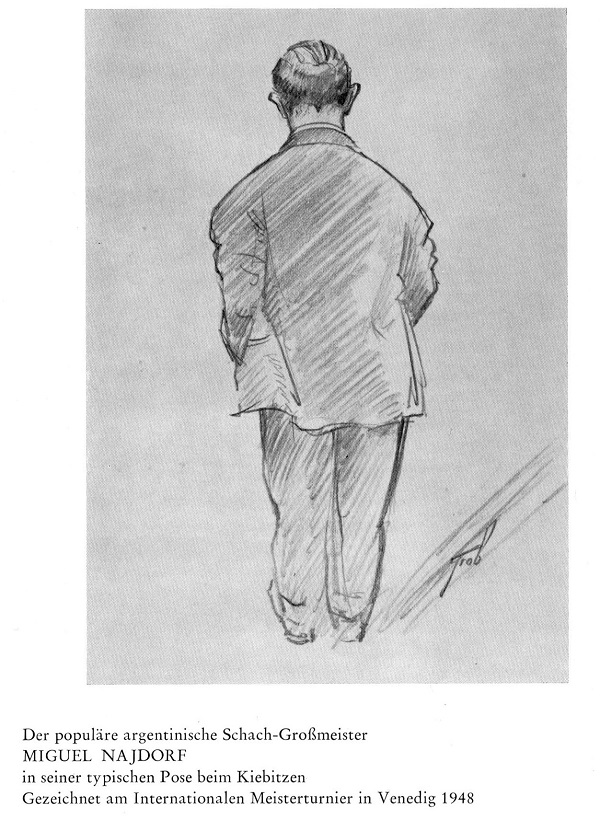
Edward Winter

Sketch by Henry Grob (C.N. 10217)
***
The present general article complements Najdorf against the French Defence, Confusion over Alekhine v Najdorf and The Polish Immortal.
Ed Tassinari (Scarsdale, NY, USA) contributes on the subject of chess predictions:
‘From Chess Life, November 1962, page 261, a piece by the US team captain Eliot Hearst on the Varna Olympiad describing Fischer’s victory over Najdorf:
“Bobby told Najdorf the day before that he would beat him in 25 moves and he kept his promise, winning very neatly in 24 moves.”’
(1359)
In C.N. 1815 Mr Tassinari wrote:
‘In January 1947, El Ajedrez Español published an interview with Najdorf titled “I am Going to Be World Champion”, excerpts of which later appeared in the March 1947 CHESS, page 169.’
See also Interregnum.
Pages 55-56 of Czerniak’s book on Buenos Aires, 1939 (not the Olympiad) give this miniature:
Luis Palau – M. Najdorf
Buenos Aires, October 1939
Sicilian Defence
1 e4 c5 2 Nc3 Nc6 3 g3 g6 4 Bg2 Bg7 5 Nge2 e6 6 d3 Nge7 7 Be3 Nd4 8 Qd2 Qa5 9 f4 d6 10 b4 Qxb4 11 Rb1 Nxe2 12 White resigns.
Alain Pallier (Avignon, France) submits the position below, which occurred at the end of the game between Najdorf and Schweber at Buenos Aires, 1968:
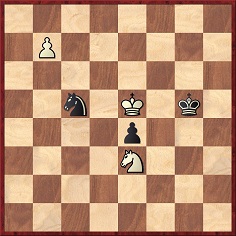
Black having just moved 63...Na6-c5, White played 64 b8(N), and the game was declared drawn.
Source: Shakhmatny Byulletin, 1/1969, page 32.
(2043)
‘When I play chess, I hardly ever calculate the play in detail. I rely very much on an intuitive sense which tells me what are the right moves to look for.’
M. Najdorf, Chess Life, November 1962, page 256:
(2583)
See also C.N. 9826.
Tartakower on Najdorf and Tartakower:
‘As for me, I am unfortunate enough not to possess a happy temperament like Najdorf, who views every happening in a rosy light and avoids every possibility of self-criticism.
I am one of those unlucky skeptics who never overlook the dark side of even the happiest experience.’
Source: Chess Review, June 1951, page 170.
(2685)
Searching for more information about the claims that Najdorf established a world record for simultaneous play in Bahía Blanca in the early 1940s, we have found a report in the May 1941 issue of the Argentinian magazine Enroque!! (ninth and tenth pages, but unnumbered). This states that on 19 April of that year (beginning at 14.30) Najdorf played 222 games at one and the same time and that when the séance ended (at about four o’clock the following morning) Najdorf had scored +202 –8 =12. Enroque!! also reported that the display was duly ratified by FIDE, via the Argentine Chess Federation, and gave one game:
Miguel Najdorf – Rodolfo M. Bentivoglio
Bahía Blanca, 1941
French Defence
1 e4 e6 2 d4 d5 3 Nc3 Bb4 4 e5 c5 5 a3 cxd4 6 axb4 dxc3 7 bxc3 Qc7 8 Nf3 Qxc3+ 9 Bd2 Qc7 10 Bd3 Nc6 11 Qe2 b6 12 O-O Nge7 13 b5 Nd8 14 Bb4 Nb7 15 Nd4 Nc5 16 f4 Bd7 17 f5 g6 18 fxe6 Nxe6 19 Nxe6 Bxe6 20 Bd6 Qd7 21 c4 Rc8 22 cxd5 Bxd5 23 Be4 Bxe4 24 Qxe4 O-O 25 Qa4 Ra8 26 Qb4 Rfe8 27 Rad1 Qb7 28 Qc4 Nf5
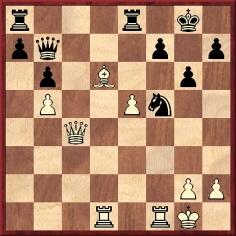
29 Rxf5 gxf5 30 Qf4 Re6 31 Qxf5 Rg6 32 Rd2 Rc8 33 h4 Rc1+ 34 Kh2 Qc8 35 Qf2 Qe6 36 h5 Rg5 37 Qf3 h6 38 Rf2 Rc4 39 g3 Rcg4 40 Qa8+ Kh7 41 Qf8 Rxh5+ 42 Kg2 Rf5 43 White resigns. The magazine pointed out that 42...Rxg3+ would have been a quicker finish.
(3419)
Christian Sánchez (Rosario, Argentina) writes:
‘The reports in the newspapers La Nación and La Prensa of Buenos Aires and La Capital of Rosario broadly agree with the magazine Enroque!! regarding Najdorf’s record, as given in C.N. 3419. The display was held at the Club Atlético Olimpo of Bahía Blanca and attracted 5,000 spectators. It began at 14.30 and ended at 04.00 the next day. However, the reports indicate irrefutably that the day the exhibition began was 1 May 1941. That Enroque!! put 19 April is doubtless an error resulting from the similarity between “19” and “1º” (the latter meaning “first” in Spanish).’
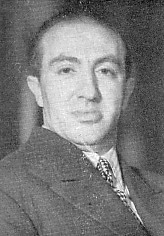
Miguel Najdorf
Our correspondent has kindly submitted transcriptions of the following reports:
(3436)
From Taylor Kingston (Shelburne, VT, USA):
‘Reading the new Najdorf: Life and Games I noticed this improbable anecdote on page 251:
“It was during the same Margate congress [i.e. 1939] that Najdorf received a compliment from Samuel Tinsley: ‘Mr Najdorf, your play is most insouciant.’ Taking this unfamiliar word to mean something like careless instead of carefree, Najdorf retorted angrily: ‘Are you insulting me?’”
Samuel Tinsley, chess columnist for The Times, died in 1903. Gaige’s Chess Personalia lists also an Edward Samuel Tinsley (a son, perhaps?), but he died in 1937. Thus attendance by either at Margate, 1939 seems unlikely.
Was there yet another Samuel Tinsley, or is this just another “good story”?’
That Edward Tinsley (1869-1937) was the son of Samuel Tinsley (1847-1903) is a fact (see, for instance, page 503 of the October 1937 BCM and page 327 of A Chess Omnibus). The BCM item stated regarding Edward Tinsley:
‘After the death of his father in 1903 he and his two brothers took over the chess work for The Times, and their collaboration continued until 1912, when Edward took full charge.’
As noted on page 147 of A Chess Omnibus, in January 1926 a radio presentation about chess on the British Broadcasting Company was made by ‘Mr S. Tinsley’, a brother of Edward. His forename was Samuel (BCM, April 1903, page 159), but we do not know whether he was still alive in 1939, whether he was the person who spoke to Najdorf or, indeed, whether the alleged 1939 exchanges occurred at all.
(3799)
See The Chess Tinsleys.
The 1936 Munich Chess Olympiad includes, from C.N. 4371, a group photograph of the Polish team, including Najdorf.
A comment by B.H. Wood on page 19 of CHESS, November 1944:
‘Najdorf is a born chess genius and, with a little of the self-discipline which he so strikingly lacks, capable of winning any world championship. At lightning chess he scintillates; we once saw him beat Tartakower (who is quite a doughty exponent of this game himself) 14 times in succession at “five-minute” play. This could not be a normal result, but it illustrates the extraordinary swing of his temperament.’
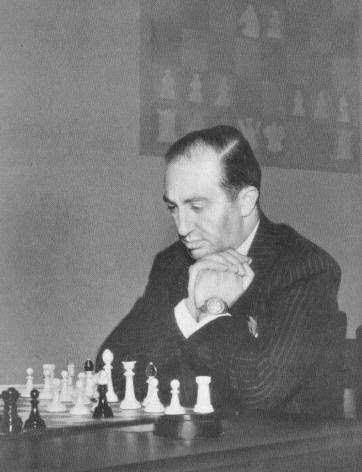
M. Najdorf
(4802)
Joost van Winsen (Silvolde, the Netherlands) raises the subject of games played by Ernesto Che Guevara (1928-67). Over the years our correspondent has collected a number of game-scores, mainly from Cuban webpages which are no longer available and which did not necessarily offer a reliable source. In the list below, only the first few moves are presented, for identification purposes, since we do not wish to give currency to any games which may be spurious.
...3) Miguel Najdorf (simultaneous) – Ernesto Che Guevara
Havana, 1962
Ruy López1 e4 e5 2 Nf3 Nc6 3 Bb5 a6 4 Ba4 Nf6 5 O-O Be7 6 Re1 b5. Drawn at move 16.
...
Chess photographs of Che Guevara are by no means scarce. For example, the following appeared on page 43 of the Cuban book on the Havana Olympiad, Cuba/66 XVII olimpíada mundial de ajedrez:
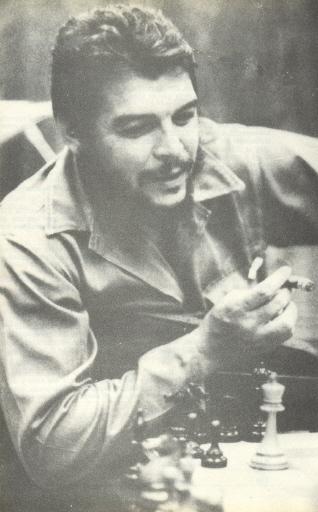
(4803)
As pointed out by Calle Erlandsson (Lund, Sweden), four games by Che Guevara were published on pages 309-311 of the 10-11/1967 number of the Cuban magazine Jaque Mate (an issue dedicated to him). Three of them were mentioned in C.N. 4803, and we now give the full scores:
...
Miguel Najdorf (simultaneous) – Ernesto Che Guevara
Havana, 1962
Ruy López
1 e4 e5 2 Nf3 Nc6 3 Bb5 a6 4 Ba4 Nf6 5 O-O Be7 6 Re1 b5 7 Bb3 d6 8 c3 O-O 9 h3 h6 10 d4 Re8 11 Nbd2 Bf8 12 d5 Ne7 13 c4 bxc4 14 Nxc4 c6 15 dxc6 Nxc6 16 Be3 Be6 Drawn.
...
(4809)
Mike Salter (Sydney, Australia) notes that whereas a 16-move draw between Najdorf and Che Guevara at a simultaneous exhibition in Havana in 1962 has been given, an unsourced quote on page 44 of Najdorf: Life and Games by T. Lissowski and A. Mikhalchishin (London, 2005) has Najdorf claiming that he won on that occasion, after refusing a draw because he wanted revenge for a loss to Che Guevara in a display at Mar del Plata in 1947.
How is the discrepancy to be explained?
(7656)
Further complications arise, as Christian Sánchez draws attention to an account by Najdorf quoted on page 86 of Liliana Najdorf’s book Najdorf x Najdorf (Buenos Aires, 1999):
‘Luego de ganar el torneo en memoria de Capablanca, el Che me invitó a jugar diez simultáneas a ciegas contra el equipo ministerial. Acepté. Él ocupó el tablero número tres. Participaron Raúl Castro, hermano de Fidel, el capitán Osmani Cienfuegos, sobrino de Camilo, el comandante Alberto Bayo y otros. El Che era un jugador bastante fuerte. Prefería el juego agresivo y dado a los sacrificios, pero bien preparados. Con él llegué a estar un poco mejor y le ofrecí tablas. Las rechazó.
– Mire, maestro – me dijo – siendo estudiante de medicina perdí contra usted en una exhibición que dio contra quince tableros en el hotel Provincial de Mar del Plata y ahora prefiero la derrota o buscar el desquite.
Acepté la invitación a la lucha y tuve que ganarle.’
Thus, compared to the version quoted in C.N. 7656 the roles of Najdorf and Che Guevara are reversed. This time, Najdorf says that he made a draw offer and that Che Guevara rejected it. See too Najdorf’s words quoted in a ChessBase article (which, incidentally, mis-dates ‘The Polish Immortal’). Moreover, the ChessBase article also refers to the Najdorf v Che Guevara game in the context of a blindfold display, which prompts Mr Sánchez to wonder whether there was more than one exhibition in Havana involving the two players.
Our correspondent has found five photographs taken during the game given in C.N. 4809 (showing Che Guevara pondering the moves 2...Nc6, 3...a6, 5...Be7 and 15...Nxc6). The five pictures include the ones given in C.N.s 4809 and 6500, as well as the following from pages 82-83 of Najdorf x Najdorf:
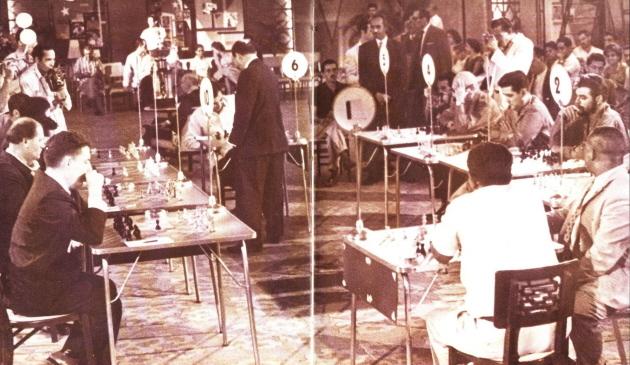
(7671)
From Pablo S. Domínguez (Madrid):
‘I quote from pages 229-230 of The King by J.H. Donner (Alkmaar, 2006):
“The following position arose after White’s 77th move and, despite the fact that the assistance of both seconds was required to convince Kotov and only after the latter had greatly upset his opponent claiming that a method had recently been found in the Soviet Union for winning this ending, there was no changing the outcome: an irrevocable draw.
Mate would only be possible after a grave error by the defender.”
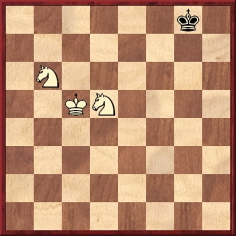
The diagram is labelled “Kotov-Najdorf Zurich 1953”. This section of Donner’s volume is described as a “fragment of an endgame book” (page 229), and on page 244 the source is given as “M. Euwe & J.H. Donner, Het Eindspel 1 Utrecht 1977”.
Firstly, we reproduce the conclusion of the game as given on page 319 of the tournament book Schach-Elite im Kampf (‘Bearbeitung der 210 Partien durch Dr. Max Euwe’):
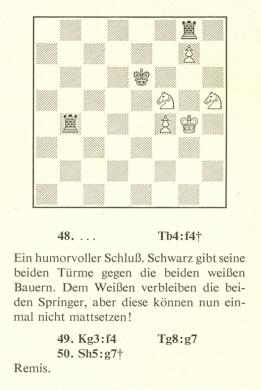
As regards possible prolongation of play, all we can add for now is what appeared at the end of the game on page 260 of The World Championship Candidates’ Tournament 1953 by B.H. Wood (material initially published as a supplement to CHESS and, as announced on page 371 of the magazine’s 18 June 1955 number, issued in book form in June 1955):
‘Now Kotov maliciously announced that he intended to play on, to see whether Najdorf might blunder into being mated inside 50 moves. Najdorf complained wildly to the tournament committee against the idea of a Grand-Master being subjected to such an indignity; and finally Kotov agreed to the draw ...’
How did the improbable story arise that the game continued until move 77?
(5042)
Regarding Raymond Keene’s treatment of the 1953 game Taimanov v Najdorf, see a brief article by Olimpiu G. Urcan.
Regarding Rubinstein’s later years, C.N. 1660 referred to statements by Najdorf on page 25 of the June 1988 Revista Internacional de Ajedrez, in an interview with Eduardo Scala:

In short, after asserting that he was an exception in being allowed into the Rubinsteins’ home Najdorf said that after the Nazis invaded Poland Rubinstein expressed delight when invited to work in a concentration camp. The Gestapo thus concluded that Rubinstein was truly insane, and the master avoided going to a death camp. The fact that Rubinstein was in Belgium, not Poland, during the Second World War, apparently passed Najdorf by.
A similar account by him was quoted on page 109 of Najdorf x Najdorf by Liliana Najdorf (Buenos Aires, 1999):
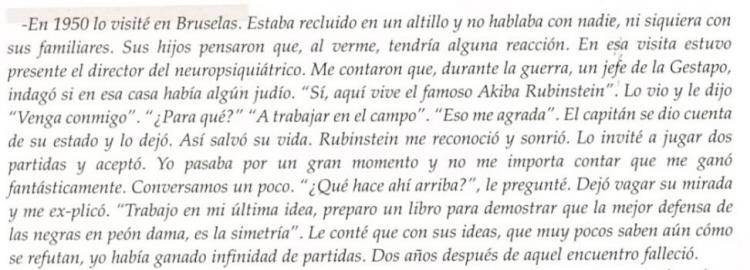
Here, M. Najdorf affirmed that in Brussels in 1950 he visited Rubinstein, who had shut himself away in an attic and spoke to nobody. Also present during the visit were Rubinstein’s sons and the director of a neuropsychiatric institute, and they told Najdorf the Gestapo story. Najdorf added that Rubinstein agreed to play two games with him and that Rubinstein won in fantastic style. Najdorf then asked him what he did in his attic, and received the following reply: ‘I am working on my latest idea; I am preparing a book to demonstrate that the best defence for Black in the Queen’s Pawn Opening is symmetry.’
Najdorf’s narrative ended by stating that two years after this meeting Rubinstein died. Since the visit purportedly took place in 1950 and Rubinstein’s death, in Antwerp, occurred on 15 March 1961, that is just one more example of the kind of discrepancy without which no reportage by Najdorf is complete. On the other hand, the comment on symmetry for Black is a reminder of a reference to Rubinstein on page 122 of the April 1940 BCM:
‘He is living in retirement in Brussels but is still actively concerned with chess analysis, notably with an exploration of the variation 1 P-Q4 P-Q4 2 P-QB4 P-QB4.’
(5250)
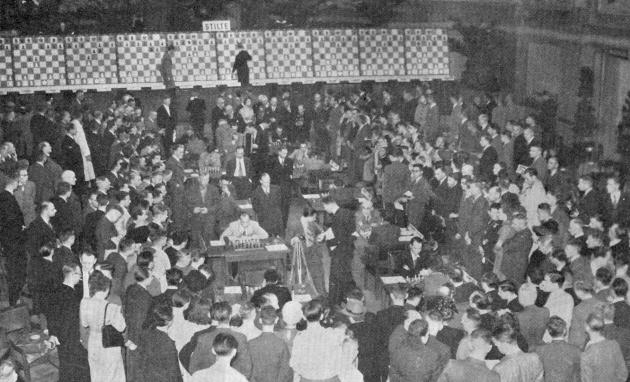
From Henk Smout (Leiden, the Netherlands), further to C.N.s 6370 and 6384:
‘In this first-round photograph (also published opposite page 32 of the book 20 grote denkers binnen Neêrlands grenzen by Peter van Foreest) the master furthest away in the left-hand row is Smyslov, playing against Vidmar. Then come Steiner, Botvinnik, Denker and (in the foreground with his back to the camera) Guimard. In the right-hand row, the first (front) master is Christoffel (back to camera), in play against O’Kelly. At the next board is Kottnauer, playing against Bernstein. Then come Yanofsky, Kotov at the board with Stoltz and, finally, Flohr. Standing behind Flohr seems to be Tartakower and behind him, on the left, Kmoch. Standing behind Botvinnik’s board, with his hands in his pockets, is Najdorf, and behind him is Euwe. Between the boards of Botvinnik and Denker, Lundin is standing on the left, and Szabó on the right. That leaves Boleslavsky. He is to the right of Najdorf and behind Szabó.
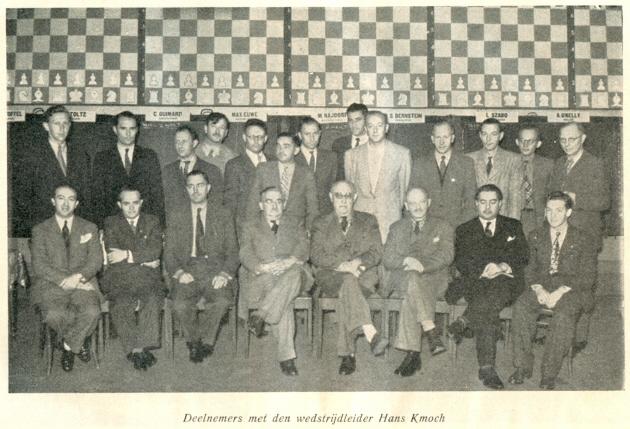
The second photograph, taken before the start of the fourth round, was given opposite page 80 of van Foreest’s book, which mentions all the names. Seated, from the left: Najdorf, Flohr, Euwe, Vidmar, Bernstein, Tartakower, Guimard and Yanofsky. Standing, from the left: Smyslov, O’Kelly, Boleslavsky, Steiner, Botvinnik, Kotov, Szabó, Kottnauer, Denker, Lundin, Stoltz, Christoffel and Kmoch.’
In the first photograph Guy Brunet (Montreal, Canada) suggests that the figure on the left watching Botvinnik’s game is Alexander Rueb.
(6425)
Page 88 of Najdorf x Najdorf by Liliana Najdorf (Buenos Aires, 1999) has a set of claims purportedly made by M. Najdorf about his over-the-board encounters:

Can corroboration of any authoritative kind be found for, in particular, the assertion that Najdorf played against Churchill in a simultaneous display?
(7689)
Christian Sánchez draws attention to a subset of Familysearch.com which comprises Brazilian immigration cards covering the period 1900-65:
‘It shows identity cards of chessplayers who travelled through Brazil from the 1940s to the 1960s, with a photograph, full name, place and date of birth, nationality, marital status, names of father and mother, profession, place of residence and signature. It is therefore possible to see, for instance, the official names of Najdorf: Mojsze Mendel Najdorf as a Polish citizen and Moisés Mendel Najdorf as an Argentine citizen. The cards also indicate that in public Najdorf used Miguel, and signed with that name. This confirms some previous Perlas Ajedrecísticas on my webpage about Najdorf.
I have translated into English one of the other Perlas: Passengers of the Piriápolis. This gives personal details about the participants in the Tournament of Nations in Buenos Aires 1939, compiled from CEMLA, a database of immigrants and passengers. It is possible, for example, to find the full names of Dez, Larsen, Lauberte, Sorensen, and particulars about such lesser-known players as Andersson, Austbo, Gudmundsson, Raclauskiene, Rometti and Winz.’
(8327)
A blindfold game from page 209 of the December 1948 Schweizerische Schachzeitung:
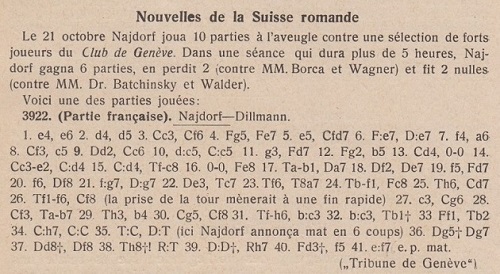
The final move has a typo, of course, and Najdorf’s announced mate was not forced (36...Kh8).
1 e4 e6 2 d4 d5 3 Nc3 Nf6 4 Bg5 Be7 5 e5 Nfd7 6 Bxe7 Qxe7 7 f4 a6 8 Nf3 c5 9 Qd2 Nc6 10 dxc5 Nxc5 11 g3 Bd7 12 Bg2 b5 13 Nd4 O-O 14 Nce2 Nxd4 15 Nxd4 Rfc8 16 O-O Be8 17 Rab1 Qa7 18 Qf2 Qe7 19 f5 Bd7 20 f6 Qf8 21 fxg7 Qxg7 22 Qe3 Rc7 23 Rf6 Raa7 24 Rbf1 Bc8 25 Rh6 Nd7
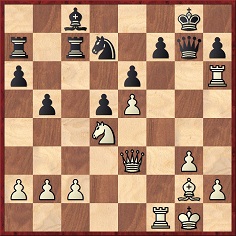
26 Rff6 Nf8 27 c3 Ng6 28 Nf3 Rab7 29 Rh3 b4 30 Ng5 Nf8 31 Rfh6 bxc3 32 bxc3 Rb1+ 33 Bf1 Rb2 34 Nxh7 Nxh7 35 Rxh7 Qxh7
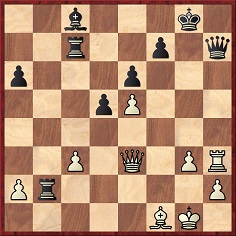
The announcement: 36 Qg5+ Qg7 37 Qd8+ Qf8 38 Rh8+ Kxh8 39 Qxf8+ Kh7 40 Bd3+ f5 41 exf6 mate.
Georges Dillmann of Geneva died on 1 August 1983, aged 61 (Schweizerische Schachzeitung, September 1983, page 366).
(9083)
See also En passant (Chess).
On pages 120-122 of the May 1946 issue of Le monde des échecs Tartakower annotated the game Najdorf v Cortlever from the 1939 International Team Tournament in Buenos Aires. His concluding notes:
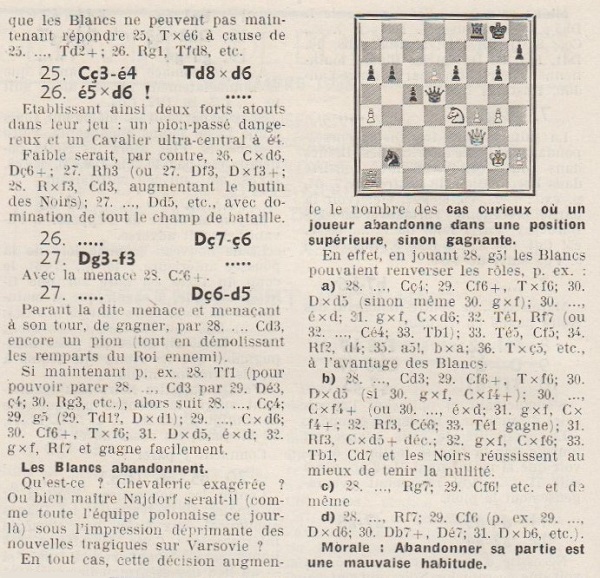
The game was also given on pages 226-227 of Chess World, 1 November 1946, under the title ‘Resigns??’. After quoting Tartakower’s final note (including ‘Moral: Resigning is a bad habit’), Purdy commented:
‘We hope beginners will not use Dr Tartakower’s witticism as an excuse for dragging on hopelessly lost games. Friendly games, by the way, should be resigned earlier than match games. By resigning quickly, you give time for another game – more fun and more practice.’
(9400)
See too Resignation in Chess.
Avital Pilpel (Haifa, Israel) writes:
‘I have from Professor Ami Barav this high-quality photograph of Najdorf during his visit to Israel in 1960-61:
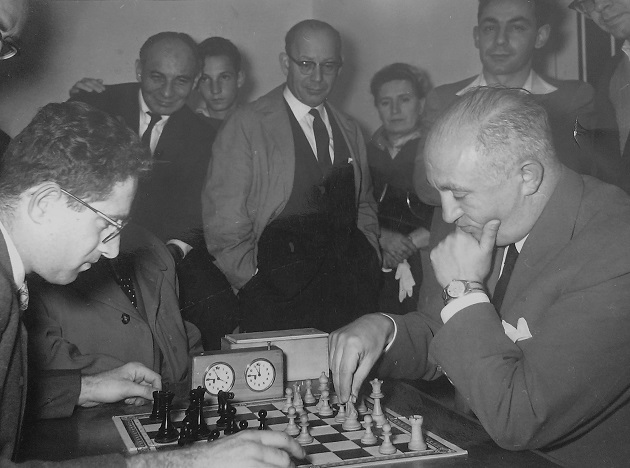
The identity of Najdorf’s opponent is uncertain. Standing on the left is Israel Barav (Rabinovich), and behind him is his son, Ami. The venue may well be the Réti Club in Tel Aviv.’
(10927)
C.N. 8045 referred to an article ‘Close to the Grandmasters’ on pages 142-143 of the April 1968 Chess Life which comprised a translation of interviews by Yuri Zarubin with Tal, Gheorghiu, Euwe, Pachman and Najdorf. Two extracts:
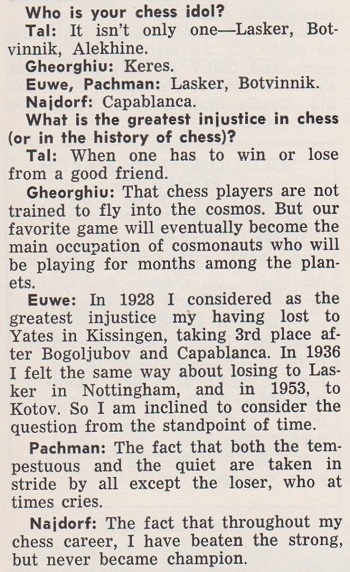
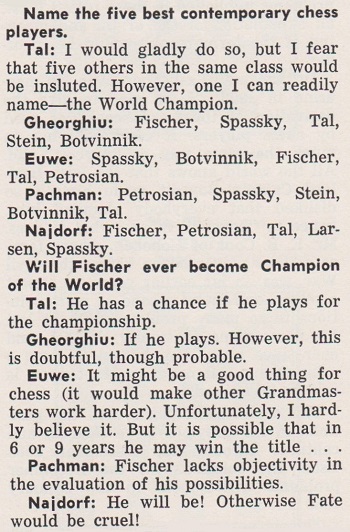
Michael Kühl (Berlin) provides the original article, from page 5 of Izvestia, 29 November 1967:
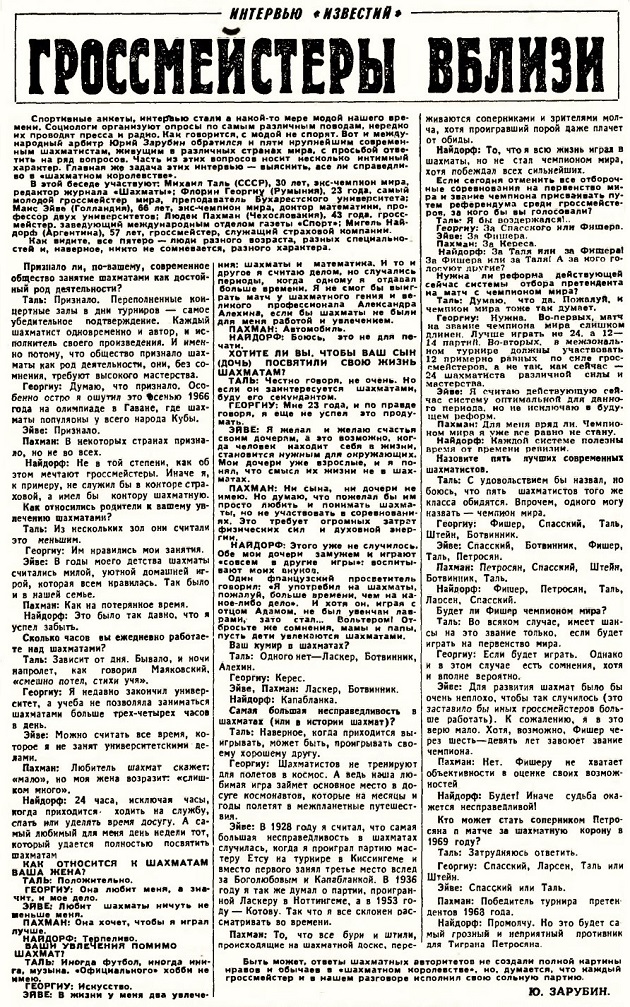
(11480)
Gerd Entrup (Herne, Germany) notes that Euwe’s (famous) loss to Kotov was not in 1953, as reported in the interview, but in 1946, in the Groningen tournament.
(11484)
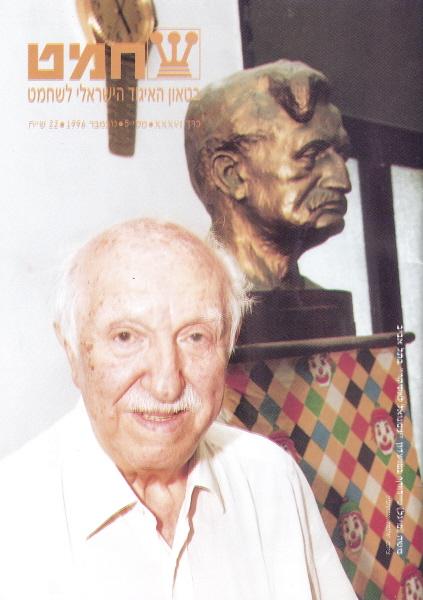
Martin Weissenberg (Savyon, Israel) forwards the front cover of the November 1996 issue of the Israeli magazine Shakhmat and comments:
‘It features Najdorf standing next to the bust of Emanuel Lasker at the Lasker Chess Club in Tel Aviv, and was taken by Shlomo Volkowitz during Najdorf’s last visit to Israel, in Autumn 1996.’
(8372)
See Chess Statues and Sculpture.
C.N. 9933 included this group photograph (Mar del Plata, 1942) from Estrategia, (April 1942, page 39):
The following comes from page 18 of the Argentinian magazine Ajedrez, January 1956:
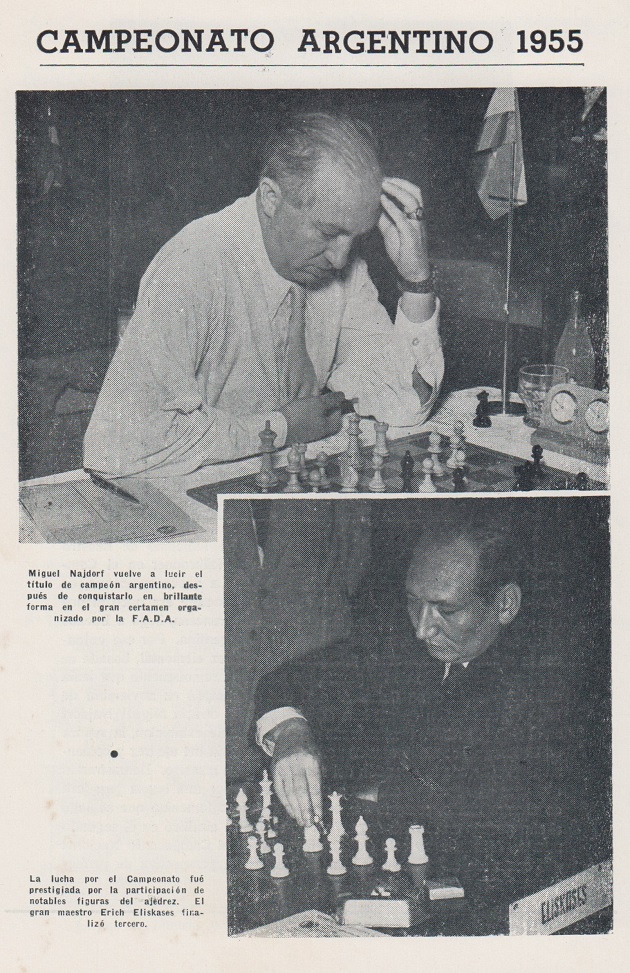
(9971)
From our collection:
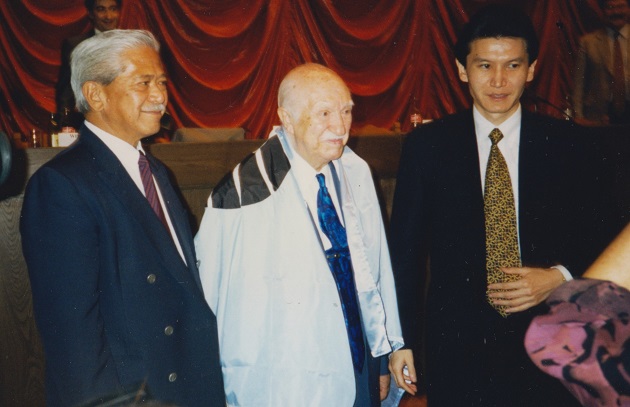
Florencio Campomanes, Miguel Najdorf, Kirsan Ilyumzhinov (Yerevan, 1996)
(10190)
C.N. 10159 showed a picture of Koltanowski drawn by Henry Grob and published on page 1 of the 4 December 1936 issue of Schach-Kurier.
Richard Forster (Zurich) notes that it is one of five portraits of chess figures in Henry Grob: der Zeichner und Maler by Henry Grob (Zurich, 1965), including the following:

(10217)
From pages 41 and 217 of Combination as a Fine Art by Werner Golz and Paul Keres (London, 1976):
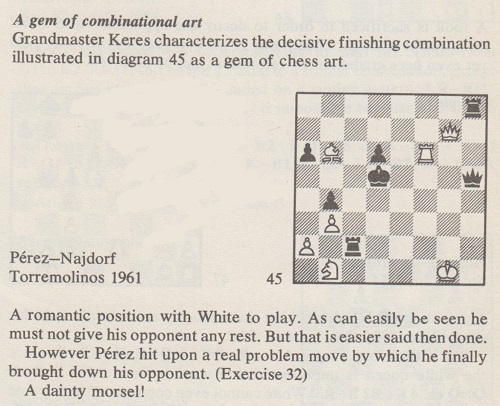
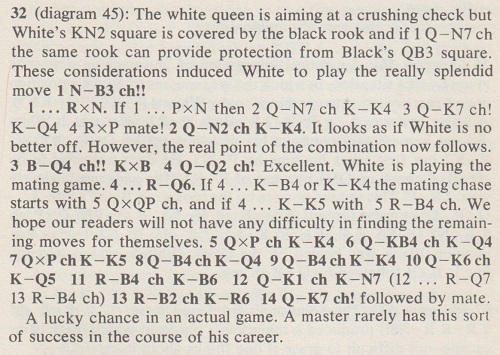
In the original German edition, Schönheit der Kombination (East Berlin, 1972), the position and solution were on pages 47 and 224.
C.N. 2111 (see pages 281-283 of Kings, Commoners and Knaves) pointed out that in reality Pérez lost the game and that the position in the Golz/Keres book did not arise. The full score was given from the tournament book:
1 e4 c5 2 Nf3 e6 3 d4 cxd4 4 Nxd4 Nf6 5 Nc3 d6 6 g3 a6 7 Bg2 Bd7 8 O-O Nc6 9 Be3 Be7 10 Qe2 Qc7 11 Rad1 Na5 12 h3 Rc8 (The tournament book had the misprint ‘Rg8’.) 13 f4 Nc4 14 Bc1 b5 15 g4 b4 16 Nb1 h6 17 b3 Nb6 18 g5 hxg5 19 fxg5 Nh5 20 Qf3 f6 21 Qg4 Qc5 22 gxf6 Nxf6 23 Qg6+ Kd8 24 Be3 Qh5 25 Nxe6+ Bxe6 26 Bxb6+ Kd7 27 Qg3 Bxh3 28 e5 Bxg2 29 Qxg2 Rxc2 30 e6+ Kxe6 31 Rde1+ Kf7 32 Rxe7+ Kxe7 33 Qxg7+ Ke6
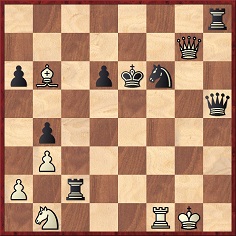
34 Qxf6+ Kd7 35 Qg7+ Kc6 36 Qc7+ Kd5 37 Qb7+ Rc6 38 Rc1 and White resigned.
The combination in the Golz/Keres book could have arisen if White had played 34 Rxf6+ instead of 34 Qxf6+.
C.N. 2111 mentioned that Keres wrote accurately about the actual version of the game-score in the Swiss newspaper Tages-Anzeiger, 28 June 1961 (although a white pawn on c2 was missing in the first diagram):
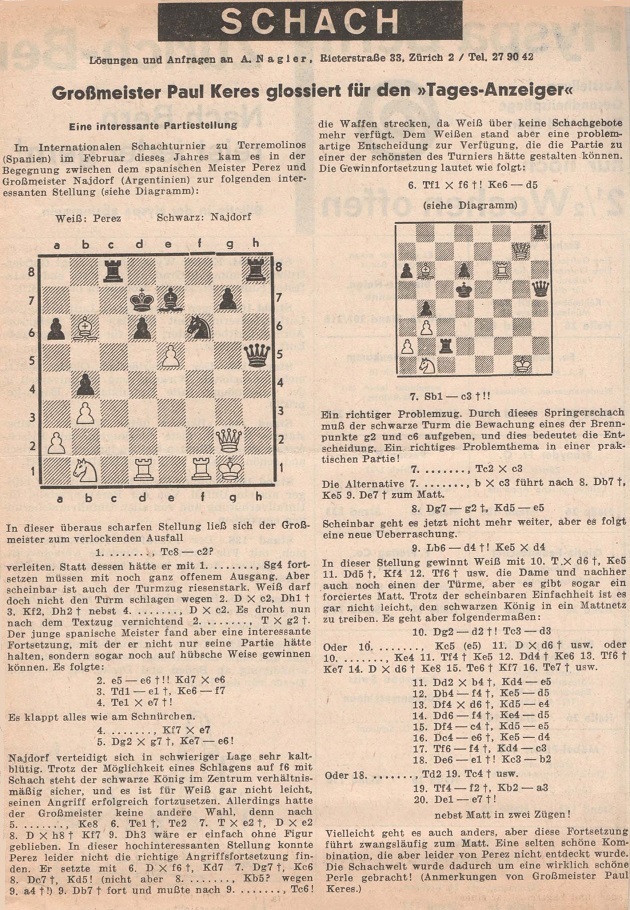
We add now that an Italian translation of Keres’ analysis was published on pages 178-179 of the September 1961 Schweizerische Schachzeitung:
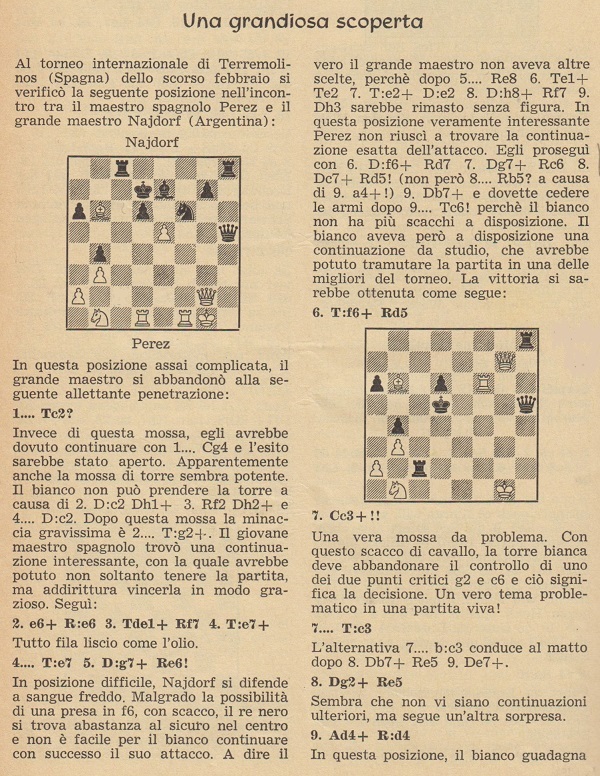
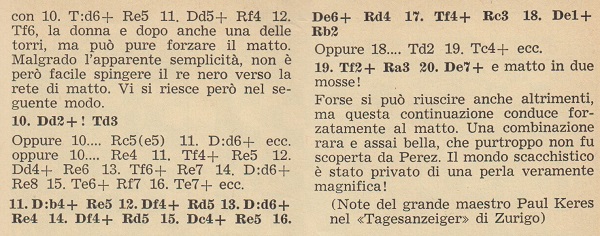
Page 225 of the December 1961 issue published a letter from a reader, Werner Schaer of Regensdorf, with an analytical correction:
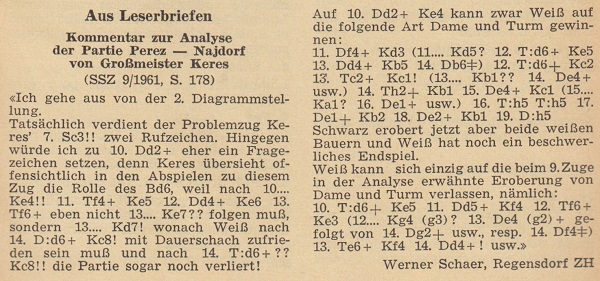
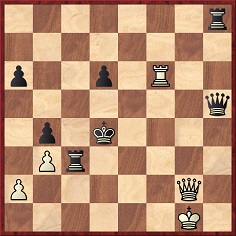
In the above position, Schaer faulted Keres’ move 10 Qd2+ on the grounds that, for instance, after 10...Ke4 11 Rf4+ Ke5 12 Qd4+ Ke6 13 Rf6+ ...
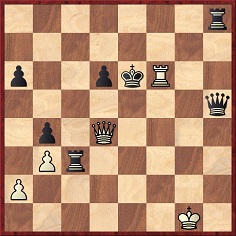
... Black has 13...Kd7, and White cannot win.
Footnote: on pages 178-179 of The Joys of Chess (Alkmaar, 2011) Christian Hesse naturally gave no credit when he repackaged C.N. 2111 under his own name.
(10223)
Thomas Niessen (Aachen, Germany) notes Kurt Richter’s treatment of the Pérez v Najdorf position on pages 312-313 of the 20/1961 issue of Schach (the second October issue):
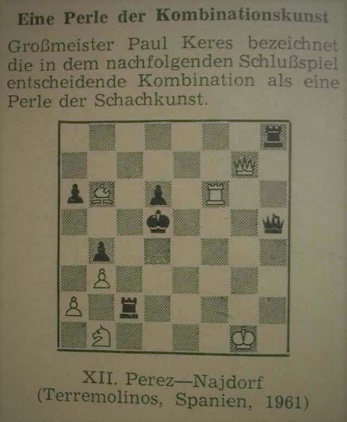

The solution was given on page 327 of issue 21/1961 of the German magazine (the first November issue):
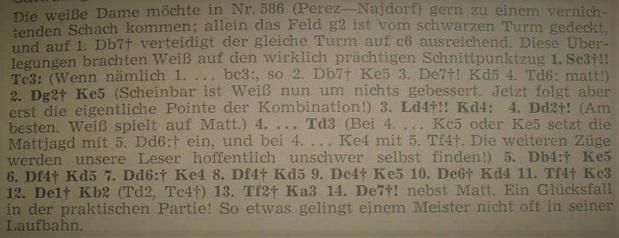
Our correspondent mentions that the texts are almost identical to what appeared on pages 47 and 224 of Schönheit der Kombination (East Berlin, 1972). In the diagram caption both sources had the spelling ‘Terremolinos’.
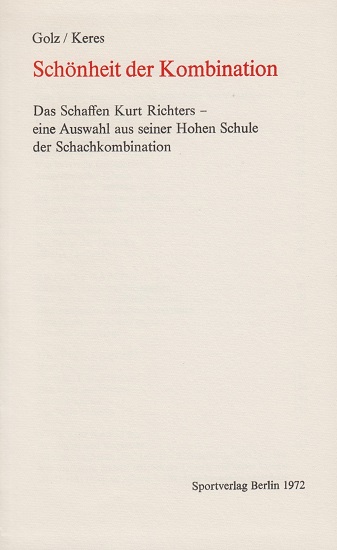
(10259)
‘It would not be too much of an exaggeration to say that this game is one long combination. This is really a way of paying tribute to White’s inexhaustible ingenuity in conjuring up new attacking ideas.’
That was Fred Reinfeld’s introduction to Pilnik v Najdorf, Mar del Plata, 24 March 1942 on page 202 of Great Brilliancy Prize Games of the Chess Masters (New York, 1961).
Below is an early appearance of the game, on page 76 of the May 1942 issue of the Argentinian chess and bridge magazine Estrategia (whose four photographs of the tournament were given in C.N. 9933):
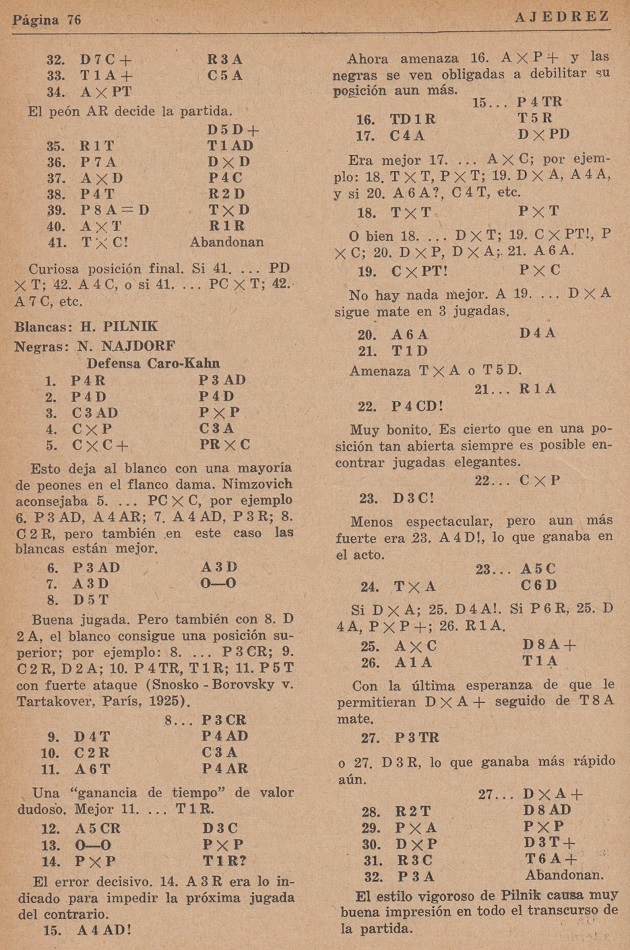
1 e4 c6 2 d4 d5 3 Nc3 dxe4 4 Nxe4 Nf6 5 Nxf6+ exf6 6 c3 Bd6 7 Bd3 O-O 8 Qh5 g6 9 Qh4 c5 10 Ne2 Nc6 11 Bh6 f5 12 Bg5 Qb6 13 O-O cxd4 14 cxd4 Re8 15 Bc4 h5 16 Rae1 Re4 17 Nf4 Qxd4 18 Rxe4 fxe4 19 Nxh5 gxh5 20 Bf6 Qc5 21 Rd1 Kf8 22 b4 Nxb4 23 Qg3 Bg4 24 Rxd6 Nd3 25 Bxd3 Qc1+ 26 Bf1 Rc8 27 h3 Qxf1+ 28 Kh2 Qc1 29 hxg4 hxg4 30 Qxg4 Qh6+ 31 Kg3 Rc3+ 32 f3 Resigns.
‘A fascinating game, beautifully handled by White from start to finish’, wrote Reuben Fine on pages 137-138 of the June-July 1942 Chess Review. His article, reproduced on pages 198-201 of Chess Marches On! (New York, 1945), was liberal with exclamation marks, and in one note a possible move for White surprisingly received four:
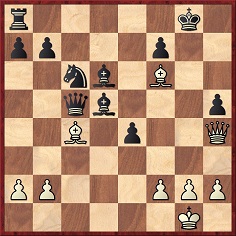
Position after 22 Rd1-d5 Be6xd5
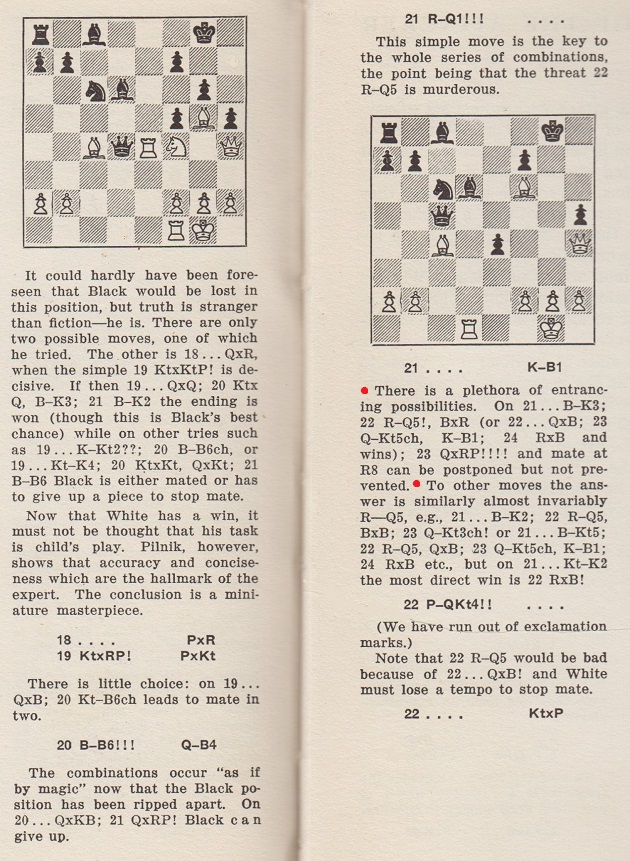
The game was also annotated on pages 122-126 of The Art of Attack in Chess by V. Vuković (Oxford, 1965). See too pages 116-120 of the algebraic edition edited by John Nunn (London, 1998).
(11192)
‘The Lugano Olympiad was the greatest manifestation of international chess the world has yet seen.’
That was the first sentence of Harry Golombek’s column in The Times, 16 November 1968, page 23.
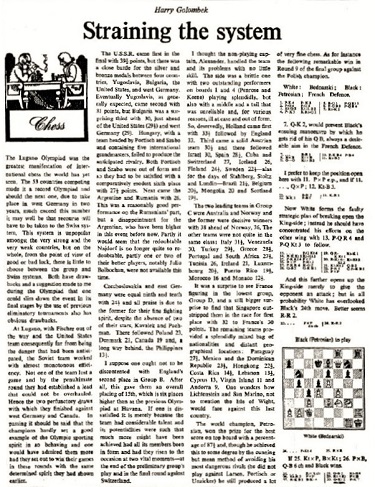
On page 334 of the December 1968 BCM Golombek reported that the conditions were not perfect:
‘Whenever spectators became numerous the air supply was not really adequate and the noise that echoed round the hall, admittedly mostly made by the players themselves when they had finished their games, proved very difficult to control. In this respect I formulated one axiom and made one observation that may be of use to students of social behaviour. The axiom is the weaker the player the bigger the noise, and to those who say “What about Najdorf?” my reply is that Najdorf is not what he was either as player or creator of noise. The observation, which was borne in on me repeatedly, is that by far the greatest decibels of noise are produced by heavily moustached gentlemen from South America. Possibly the scientific reason for this is the greater force necessary to make themselves heard through the hair.’
(11223)
An addition to Chess: The Greatest comes from a report by Miro Radojčić on his conversation with M. Najdorf at the 1968 Olympiad in Lugano. Najdorf asserted:
‘Whether the great ones of the past played better or not is hardly the real question. Nobody could answer that. But what one could say and what is certainly true is that grandmasters from past generations played much more interesting chess than those of today. Theirs were creative minds in complete contrast with the majority of contemporary stars who are rather hard workers and imitators more than anything else.’
Source: Chess Life, January 1969, page 9.
(11258)
From an article by Jeremy Gaige, ‘The Ethics of Chess’, on page 106 of Chess Review, April 1961:
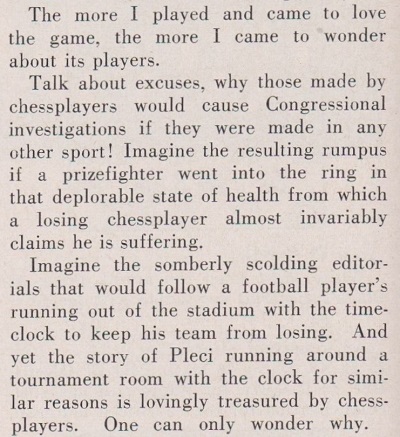
The story is related on, for instance, pages 82-83 of The Chess Scene by David Levy and Stewart Reuben (London, 1974):
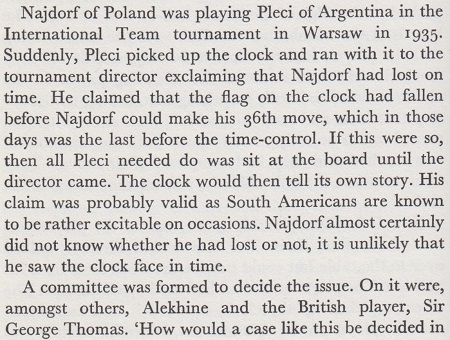

No source was given, naturally, but the ease with which anyone can fill space with such stuff is demonstrated by this extract from a ‘Round the Chess World’ article by G. Koltanowski on page 77 of CHESS, 14 October 1935:
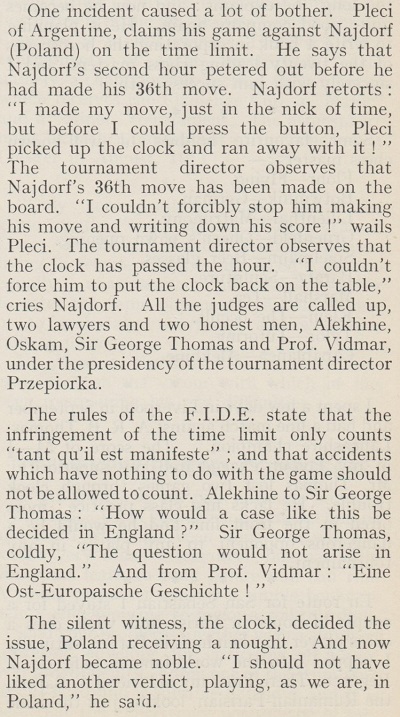
The episode was also related on page 18 of Najdorf: Life and Games by T. Lissowski and A. Mikhalchishin (London, 2005). The conclusion:
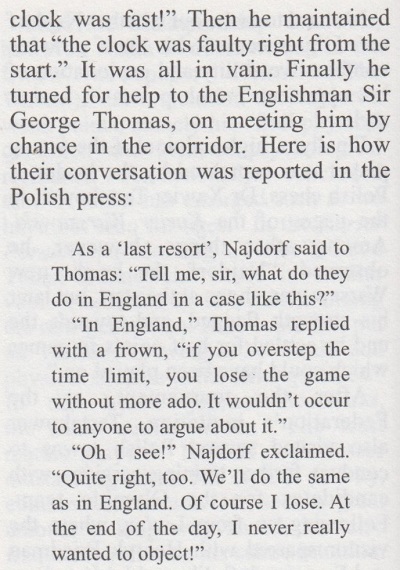
On the strict basis of authoritative accounts, and ideally with the game-score, how can the incident best be summarized in a brief paragraph?
(11395)
From Christian Sánchez:
‘On pages 111-112 of Jaque mate (Barcelona, 1972), a book originally published in 1965, Kurt Richter gave a game with a brilliant finish played by M. Najdorf in an undated simultaneous display:
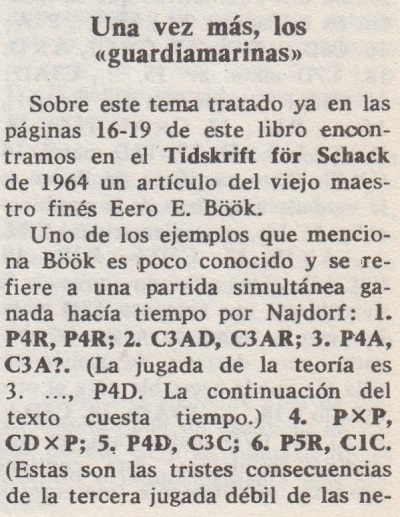

1 e4 e5 2 Nc3 Nf6 3 f4 Nc6 4 fxe5 Nxe5 5 d4 Ng6 6 e5 Ng8 7 Nf3 d6 8 Bd3 dxe5 9 dxe5 Bc5 10 Qe2 Bg4 11 Ne4 Bb6 12 Bg5 Qd5 13 Rd1 Qa5+ 14 c3 Nxe5 15 Bb5+ Kf8 16 Nxe5 Bxe2 17 Nd7+ Ke8 18 Nb8+ c6 19 Nd6+ Kf8 20 Nd7 mate.
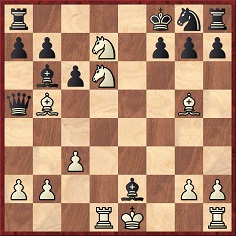
As his source Richter named the Tidskrift för Schack, 1964. The game is on pages 134-135 of the June issue:
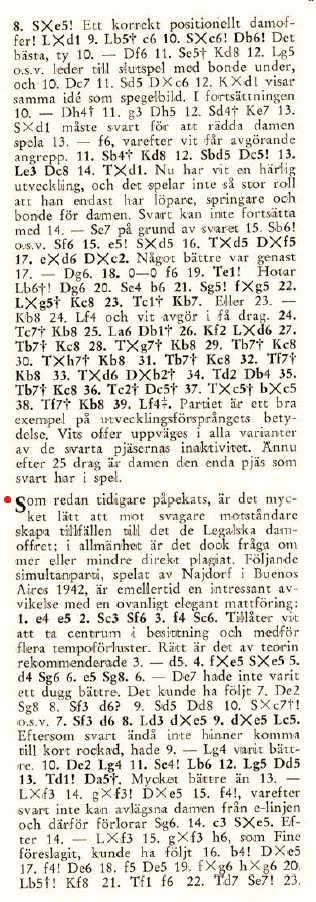
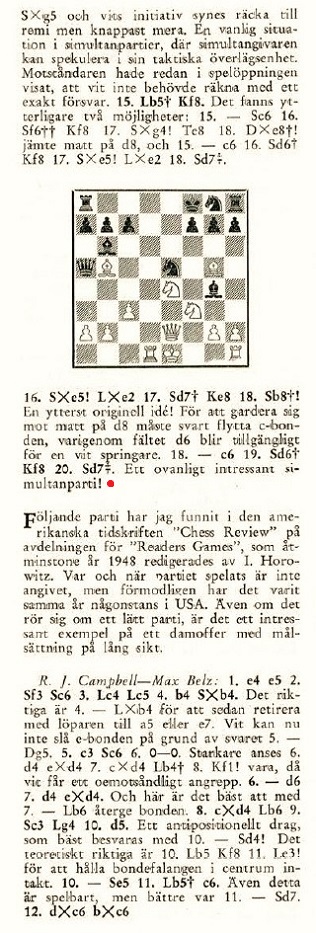
Although Böök’s article above stated that the game was played in Buenos Aires in 1942, pages 366-367 of Ajedrez Español, December 1944 had the heading “Argentina, 1944”:
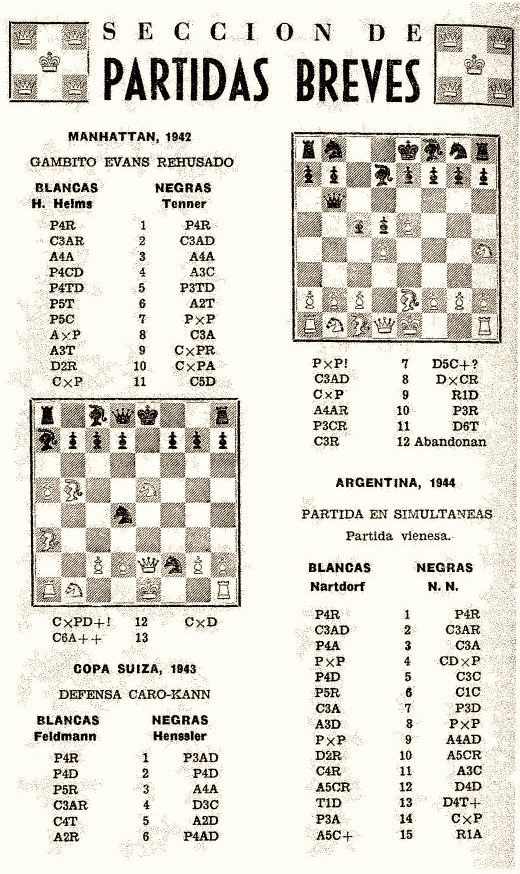
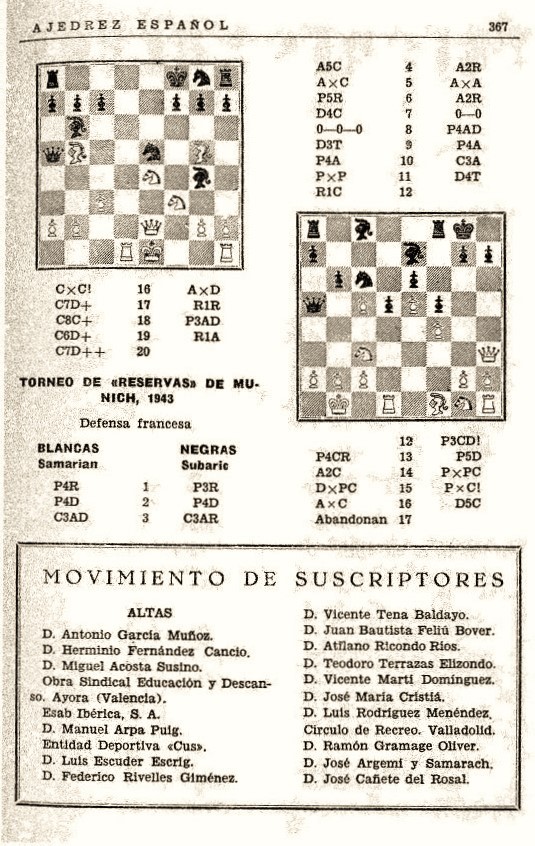
(11786)
Michael McDowell (Westcliff-on-sea, England) notes that the Najdorf miniature was published on page 211 of Chess Marches On! by Reuben Fine (New York, 1945). Two exclamation marks were awarded to 16 Nxe5, and three to 18 Nb8+.
Although the heading was ‘Buenos Aires, 1942’, the previous page stated that the game was ‘played by Najdorf in Argentina last year’.
(11792)
See also:
To the Archives
for other feature articles.
Copyright Edward Winter. All rights reserved.